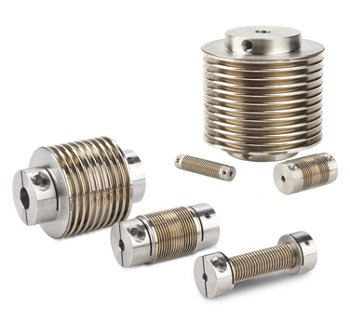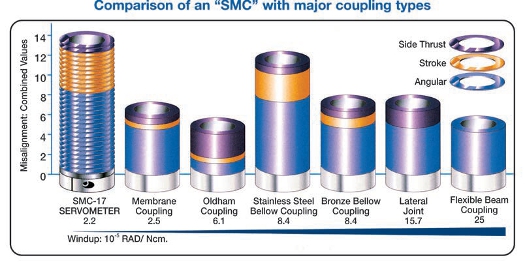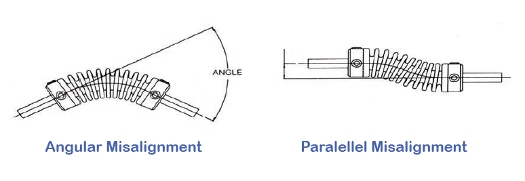 |
| March 21, 2017 | Volume 13 Issue 11 |
Designfax weekly eMagazine
Archives
Partners
Manufacturing Center
Product Spotlight
Modern Applications News
Metalworking Ideas For
Today's Job Shops
Tooling and Production
Strategies for large
metalworking plants
From tanks to medical devices: Flexible coupling solutions
Electrodeposited nickel bellows couplings flex to fit misaligned shafts yet remain torsionally stiff.

What do a micron-precision silicon wafer cutter, a surgical microscope focusing mechanism, and a target-sighting system for an MIA2 Abrams tank all have in common? Each contains an electrodeposited nickel bellows coupling.
Such couplings excel in instrumentation and fractional-horsepower applications but are occasionally overlooked because they tend to cost more than other types. Couplings are typically rated by their torque capacity, rotational inertia, resistance to the elements, service life, windup and backlash levels, and flexibility. By all these measures, electrodeposited bellows couplings compare favorably to competitive designs.
It's all about the manufacturing
Making this possible is the electrodepositing process itself. Servometer builds its nickel bellows by electrodepositing a nickel layer upon a machined aluminum mandrel to a precise thickness and diameter. Dissolving the mandrel leaves behind a lightweight, convoluted tube, which is the flexible bellows. Servometer then bonds the bellows to the aluminum hubs or soft-solders them to stainless steel hubs.
VIDEO: Electrodeposited metal bellows, flexible shaft couplings, electrical contacts, and structurally rigid electroforms are manufactured by Servometer using a proven five-step manufacturing process.
Electrodeposited bellows can be made as small as 0.5 mm (.020 in.) in diameter and with walls as thin as .008 mm (.0003 in.), smaller in diameter or thinner in wall thickness than comparable mechanically formed hydroformed bellows. The geometry of electrodeposited bellows allows Servometer to fit more convolutions into a given length than hydroformed bellows, giving them even more dynamic flexibility. Thinner walls lower the rotational inertia, which, in turn, cuts drive power losses during intermittent operation. The thinner convolutions, along with the highly ductile nickel material, boosts flexibility to minimize side forces between misaligned shafts. A test-instrument maker, for example, saved on production costs by connecting a servomotor and tachometer with a nickel bellows coupling rather than a rigid coupling.
The bellows coupling paid for itself by eliminating a costly laser-alignment procedure. Other precision positioning applications, such as the silicon wafer cutter, need exceptionally tight mechanisms to keep input and output shafts rotationally aligned. Here, less costly rigid couplings work because they handle the high torque levels without windup or backlash. However, shafts and bearings may fail prematurely when they encounter angular or parallel misalignment or axial forces.

Bellows-type couplings, in contrast, tolerate deliberate lateral and axial motion or assembly misalignment yet remain torsionally rigid. Their convoluted bellows transmit torque with negligible windup as they bend, compress, and extend.
Handling misalignment with ease
Bellows-type couplings can handle over 30 times the angular misalignment and can compress or extend 15 times more than Oldham couplings. Electrodeposited bellows couplings, depending on design, can operate with up to 31° angular or 1.73-mm (.068-in.) parallel misalignment. Side thrust in most cases is limited to about 4N/.1 mm of offset.

Good flexibility also helps isolate vibration. Elastic windup is typically less than 10 arc-sec/N-cm, or about one-fourth that of hydroformed bronze or stainless-steel bellows. This is why a maker of windup-measurement instruments specified a Servometer electroformed nickel bellows coupling to connect a drive to a position encoder. The couplings are also ideal for linking encoders with controls in printing and converting equipment. A high torsional rigidity helps the machines maintain precise registration.
Other important metrics include concentricity and service life. Servometer typically holds concentricity of electrodeposited bellows couplings to within 12.7?m (.0005 in.). Cyclic speed variation through 360° rotation is effectively zero. When run within recommended limits, the couplings have a near-infinite life (108 cycles). Designers of the Abrams tank sighting system chose a Servometer bellows coupling for its high cycle life because they could not tolerate a coupling failure inside the sealed sensor assembly. Likewise, Global Positioning Systems satellites use multiple electrodeposited nickel bellows to tune microwave antennas that cannot be repaired on orbit. The seamless, non-porous electrodeposited bellows hold up to the harsh space environment and keep the precision drives they connect contamination-free.
VIDEO: Finding the right coupling for your motion control application is easy.
-----------------------------------------------------
Design considerations
Maximum instantaneous torque from a clutch start or brake stop
For a low-inertia motor coupled to a gear-reduction drive, multiply motor-starting torque by the reductions ratio. For bellows couplings operating compressed, use 75% of rated torque, max. Extended couplings use normal torque ratings.
Duty cycle
Consider torque spikes, especially for quick reversals or frequent start-stops, such as the short stepping moves of an index table. These put added loads on drive couplings.
Axial compression or extension
Electrodeposited nickel bellows can compress up to 60% of their extended length.
Temperature extremes
Soldered-hub electrodeposited bellows couplings can operate continuously at temperatures from -58° F to 260° F (-50° C to126° C).
Chemical environment
Nickel bellows will not oxidize in air or alkaline fluids.
Windup
Shorter-length or larger-diameter couplings lessen windup.
About Servometer and BellowsTech
Servometer, the pioneer of electrodeposited miniature metal bellows, bellows assemblies, contact springs, flexible shaft couplings, and rigid electroforms, offers over 50 years of engineering and manufacturing experience servicing the aerospace, defense, medical, test, semiconductor, UHV, solar, and oil and gas industries. Servometer is ISO 9001:2008 certified.
In 2007, Servometer acquired BellowsTech of Ormond Beach, FL, a premiere manufacturer of edge-welded bellows and bellows assemblies encompassing a wide array of alloys and dimensional configurations for oil and gas, semiconductor, and vacuum technology industries. BellowsTech is AS9100-C compliant.
Learn more about Servometer at servometer.com. Learn more about BellowsTech at bellowstech.com.
Published March 2017
Rate this article
View our terms of use and privacy policy
